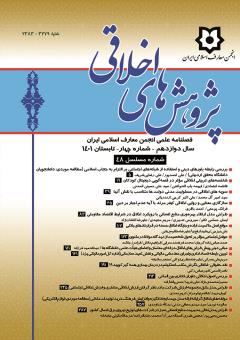طراحی مدل تعالی مدیریت منابع انسانی سبز در شرکت های توزیع نیروی برق شمال کشور
محورهای موضوعی : Ethics and Islamic Educationمحسن یحیی پور 1 , مجتبی طبری 2 * , اسداله مهر آرا 3 , محمدرضا باقرزاده 4 , عزت الله بالوئی جامخانه 5
1 - دانشگاه ازاد اسلامی واحد قائمشهر
2 - دانشگاه آزاداسلامی واحد قائمشهر
3 - دانشگاه آزاداسلامی واحد قائمشهر
4 - دانشگاه آزاد اسلامی واحد قائمشهر
5 - دانشگاه آزاداسلامی واحد قائمشهر
کلید واژه: مدیریت منابع انسانی سبز, آموزش, کاربرد, حفظ و نگهداری, جذب و تامین,
چکیده مقاله :
هدف پژوهش حاضر طراحی مدل تعالی مدیریت منابع انسانی سبز در شرکتهای توزیع نیروی برق شمال کشور است. جامعه آماری پژوهش شامل دو بخش خبرگان و کارکنان و روش جمع آوری اطلاعات به دو صورت کتابخانهای و میدانی میباشد. جهت تبیین روابط ساختاری عوامل مدل تعالی مدیریت منابع انسانی سبز از تکنیک دیمتل، برای تعیین وزن عوامل شناسایی شده با استعانت از مدل ایزو 34000 منابع انسانی، از آزمون دالالا و جهت ارزیابی عوامل و اولویت بندی آنها از تکنیک AHP استفاده شد. براساس تحلیل معادلات ساختاری نیز مشخص شد که هر چهار نظام با مدیریت منابع انسانی سبز از دید کارکنان نیز دارای ارتباط میباشند و بیشترین ارتباط مرتبط با آموزش و کمترین ارتباط با کاربرد میباشد. در نتیجه مدل طراحی شده پژوهش، تاثیر نظامهای مدیریت منابع انسانی بر مدیریت منابع انسانی سبز را تائید میکند و براساس نتیجه تکنیک AHP از دید خبرگان، به ترتیب اولویت با آموزش و بهسازی، حفظ و نگهداری، جذب و تامین و کاربرد میباشد و با توجه به پشتوانه نظری، توافق بالای خبرگان و محاسبات آماری برازش مدل، دارای اعتبار بوده و میتواند به عنوان معیاری برای پژوهشهای آتی در جهت ساخت ابزاری برای انجام پژوهشهای مرتبط باشد.
The purpose of the present study is to design a model of excellence of green human resource management in electricity distribution companies in north of Iran. The statistical population of the study consists of two sections of experts and staff and the method of collecting information in both library and field form. DEMATEL technique was used to explain the structural relationships between the factors of green human resource management excellence model, the Dallala test was used to determine the weight of factors identified by ISO 34000 HR model, and the Analytical Hierarchy process(AHP) technique was used to evaluate factors and prioritize them. Based on the structural equation analysis, it was also found that all four systems are associated with green human resource management from the employees' point of view, and the highest relationship is related to education and the least to application. As a result, the designed research model confirms the impact of human resource management systems on green human resource management and based on the result of AHP technique from the point of view of experts, priority is given to training and improvement, keep, recruitment and application and according to Theoretical support, high agreement of experts and statistical calculations of model fit are valid and can be used as a criterion for future research in order to build a tool for related research.
Aarabi, S.M, M, fayyazi. (2016). Human resource management linking strategy to practice, Mahkameh Publications, Tehran, Iran, pp 4-6.
Fleming, et al. (2017). The sustainable development goals: A case study, Marine Policy, 86, 94–103.
Amrutha VN, Geetha SN. (2019). A systematic review on green human resource management: Implications for social sustainability, Journal of cleaner production, Volume 247, DOI: http://doi.org/10.1016/j.jclepro.2019.119131.
E. bombiak, A. marciniuk-kluska. (2018). Green Human Resource Management as a Tool for the Sustainable Development of Enterprises: Polish Young Company Experience. Journal of sustainability. 22-46.
Gholipour, A. (2017). Model 34000 Human Resources (Standard Award 34000). Mehraban Book Institute, Tehran.
Hiba A. M, A. A.M. Jaaron. (2017). Assessing Green Human Resources Management practices in Palestinian manufacturing context: An empirical study. Journal of Cleaner Production, Volume 143, 474-489.
Jabbour, C. J. C., Jabbour, A. B. L. de S. (2016). Green human resource management and green supply chain management: linking two emerging agendas. Journal of Cleaner Production, 112, 1824-1833.
Jackson, S. E., Renwick, D. W. S., Jabbour, C. J. C., Müller-Camen, M. (2011). State-of-the-art and future directions for green human resource management: Introduction to the special issue. German Journal of Human Resource Management, 25, 99-116.
Kim YJ, et al. (2019). The effect of green human resource management on hotel employees’ eco-friendly behavior and environmental performance. International Journal of hospitality management, 76, 83-93.
Mehta K., Chugan P.K. (2015). Green HRM in pursuit of environmentally sustainable business. Universal Journal of Industrial and Business Management, 3, 74-81.
Mir Sepasi, N. et al. (2010). Designing Human Resource Excellence Model in Iranian Governmental Organizations Using Fuzzy Delphi Technique. Journal of Management Research, No. 87, 1-23.
Pham NT, et al. (2019), The role of green human resource management in driving hotel’s environmental performance: interaction and mediation analysis. International Journal of hospitality management, Volume 88, 102392. DOI: https://doi.org/10.1016/j.ijhm.2019.102392
Pham NT, et al. (2019). Greening the hospitality industry: how do green human resource management practices influence organizational citizenship behavior in hotels?A mixed methods study. Journal of Tourism management, 72, 386-399.
Seyyed Javadin, S. R. et al. (2016). Green Human Resource Management an Investment and Sustainable Development Approach, Tehran. Journal of Investment Knowledge, Fifth Year, No. 20.
Seyed Javadin, S. R, et al. (2016). Providing a Coherent Framework for Green Human.

